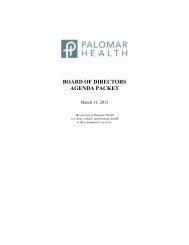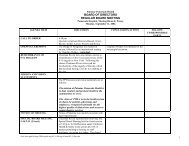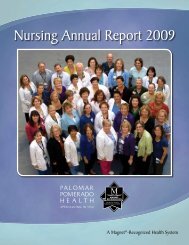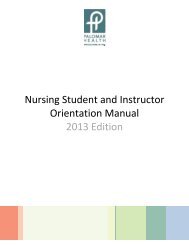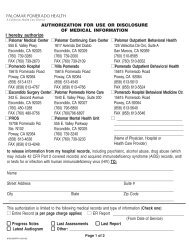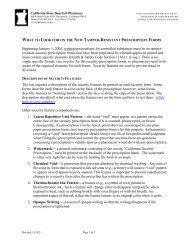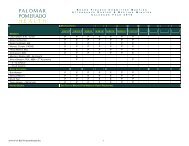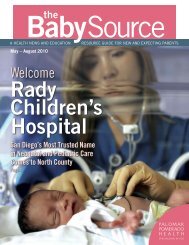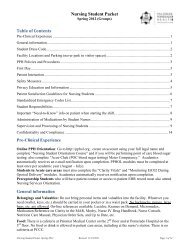Planning the Perfect Delivery - Palomar Health
Planning the Perfect Delivery - Palomar Health
Planning the Perfect Delivery - Palomar Health
Create successful ePaper yourself
Turn your PDF publications into a flip-book with our unique Google optimized e-Paper software.
A HEALTH NEWS AND EDUCATION<br />
January – April 2007<br />
RESOURCE GUIDE FOR NEW AND EXPECTING PARENTS<br />
<strong>Planning</strong> <strong>the</strong><br />
<strong>Perfect</strong> <strong>Delivery</strong><br />
Pages 4 – 5<br />
High-Risk Pregnancy Care<br />
<strong>Palomar</strong> Medical Center Opens<br />
New Perinatal Testing Center<br />
Page 9<br />
Packing a <strong>Health</strong>y Lunch<br />
Discover <strong>the</strong> Ideal Lunchbox for Kids<br />
Page 11<br />
Earaches, Sniffles and<br />
Sneezes<br />
Know When to See <strong>the</strong> Doctor<br />
Page 12
Poway<br />
Pomerado Hospital<br />
15615 Pomerado Road<br />
Poway, CA 92064<br />
858.613.4000<br />
Women’s <strong>Health</strong> Connection<br />
Gateway Medical Building<br />
15725 Pomerado Road<br />
Suite 100<br />
Poway, CA 92064<br />
858.613.4894<br />
Class Locations<br />
San Marcos<br />
The <strong>Health</strong>Source<br />
120 Craven Road<br />
Suite 103<br />
San Marcos, CA 92069<br />
Escondido<br />
<strong>Palomar</strong> Medical Center<br />
555 East Valley Parkway<br />
Escondido, CA 92025<br />
760.739.3000<br />
Volume 3 – Issue 1<br />
January – April 2007<br />
Editor-in-Chief<br />
Janet Gennoe Klitzner<br />
Director of Marketing & The <strong>Health</strong>Source<br />
janet.gennoe@pph.org<br />
Content Editors<br />
Mary Coalson<br />
<strong>Health</strong> Education Specialist<br />
mary.coalson@pph.org<br />
Off-site classes are also available for groups,<br />
businesses and o<strong>the</strong>r organizations that<br />
would like instruction on a particular<br />
health topic. Call 858.675.5372 for more<br />
information.<br />
The <strong>Health</strong>Source retains <strong>the</strong> right to<br />
cancel a community education class if<br />
minimum enrollment is not met. If you<br />
have a disability, please notify us 72<br />
hours prior to <strong>the</strong> event so that we may<br />
provide reasonable accommodations.<br />
Numbers to Know<br />
Keep <strong>the</strong>se important numbers handy for use in <strong>the</strong> event of an emergency.<br />
Emergency Crisis Hotlines – 24-Hour Service<br />
Fire, Police or Emergency 911<br />
Poison Control 800.222.1222<br />
California Missing Children Hotline 800.222.3463<br />
California Youth Crisis Hotline 800.843.5200<br />
Child Abuse Hotline 800.344.6000<br />
Rape/Crisis Hotline 888.272.1767<br />
Domestic Violence Hotline 888.385.4657<br />
Missing, Abused & Exploited Children 888.818.4673<br />
National Runaway Switchboard 800.621.4000<br />
Vanished Children’s Alliance (VCA) 800.826.4743<br />
Domestic Violence & Rape Crisis Hotline 760.757.3500<br />
Youth Crisis Hotline 800.448.4663<br />
Tammy Chung<br />
Assistant to The <strong>Health</strong>Source<br />
tammy.chung@pph.org<br />
Contributors<br />
Gustavo Friederichsen<br />
Chief Marketing & Communications Officer<br />
gustavo.friederichsen@pph.org<br />
Tami Weigold<br />
Marketing Manager<br />
tami.weigold@pph.org<br />
Kathy Lunardi, R.N.<br />
Community Nurse Educator<br />
kathryn.lunardi@pph.org<br />
CeCe Wilkens<br />
Wilkens Communications<br />
Jennifer Decker Arevalo<br />
PSY/MED Media<br />
Design/Production<br />
Chase Design<br />
info@chrischasedesign.com<br />
Trina Hinch<br />
Marketing Project Manager<br />
trina.hinch@pph.org<br />
Mark Seal<br />
Rush Press<br />
Photography<br />
Janet Gennoe Klitzner<br />
Director of Marketing & The <strong>Health</strong>Source<br />
Suicide and Crisis Counseling 800.479.3339<br />
San Diego Police Department 619.531.2000<br />
2 JANUARY – APRIL 2007<br />
www.pph.org
SPECIAL FEATURES<br />
Inside this Issue …<br />
SPECIAL FEATURES<br />
4 - 5 Great Expectations: <strong>Planning</strong> <strong>the</strong> <strong>Perfect</strong> <strong>Delivery</strong><br />
From doulas and midwives to birth plans and birth methods, learn<br />
more about <strong>the</strong> many options of childbirth.<br />
7 Five-Star Care at PPH Birth Centers<br />
Discover <strong>the</strong> delivery experience new moms can expect at <strong>Palomar</strong><br />
Medical Center and Pomerado Hospital.<br />
8 Library of Love<br />
The Women’s <strong>Health</strong> Connection in Poway features an extensive<br />
lending library. Check out <strong>the</strong> top 10 most requested books by new<br />
and expecting parents.<br />
9 High-Risk Pregnancy Care<br />
Women in North County now have access to high-risk pregnancy<br />
diagnostic tests and counseling services through <strong>the</strong> new Perinatal<br />
Testing Center at <strong>Palomar</strong> Medical Center.<br />
10 Watching Baby Grow: Seven to Nine Months<br />
Learn more about <strong>the</strong> developmental milestones to look for during<br />
months seven through nine of your baby’s life.<br />
11 Packing a <strong>Health</strong>y Lunch<br />
A registered dietitian shares her “ideal lunchbox” for kids.<br />
12 Earaches, Sniffl es and Sneezes: Know When to See <strong>the</strong> Doctor<br />
Is it a cold, an ear infection, sinusitis or allergies? A local<br />
pediatrician discusses <strong>the</strong> four most common ailments among<br />
young children.<br />
14 New Vaccine Protects Against Cervical Cancer<br />
Learn <strong>the</strong> latest about <strong>the</strong> HPV vaccine, recommended for girls<br />
between <strong>the</strong> ages of nine and 26.<br />
Finding a Physician<br />
To select a <strong>Palomar</strong> Pomerado <strong>Health</strong> physician<br />
for your pre-pregnancy and pregnancy care, or<br />
to register for a PPH childbirth class, please call<br />
The <strong>Health</strong>Source at 800.628.2880.<br />
EDUCATION<br />
6 Childbirth Preparation Classes<br />
<strong>Palomar</strong> Pomerado <strong>Health</strong> offers a wide variety of classes and<br />
services to help you and your partner prepare for pregnancy and<br />
delivery.<br />
8 Breastfeeding Classes and Lactation Services<br />
10 Meet <strong>the</strong> Instructor<br />
Chuck Flacks provides “dads-to-be” with basic training on caring<br />
for <strong>the</strong>ir new baby.<br />
11 Infant- & Toddler-Care Classes<br />
Take advantage of our special presentation infant- and toddler-care<br />
classes including Baby-Care Basics, Baby Sign Language, Infant<br />
Massage, and our newest offering, Soothing and Sleep Strategies.<br />
13 – 14 Sibling Education, Young Adult, CPR and First-Aid Classes<br />
Stork Club Tours<br />
Call for dates, times and locations.<br />
Tours of <strong>the</strong> Birth Centers at <strong>Palomar</strong><br />
Medical Center and Pomerado Hospital are<br />
available by appointment only. If you are<br />
taking a childbirth class at The Women’s<br />
<strong>Health</strong> Connection or <strong>Palomar</strong> Medical<br />
Center, <strong>the</strong>re is no need to take this tour as<br />
well. Tours of <strong>the</strong> Birth Center at <strong>Palomar</strong><br />
Medical Center are available in Spanish on<br />
<strong>the</strong> 2nd and last Wednesdays of each month<br />
from 7 to 8:30.<br />
FEE: Free<br />
For a physician referral, or to register for a class, call The <strong>Health</strong>Source at 800.628.2880.<br />
3
Great Expe<br />
<strong>Planning</strong> <strong>the</strong><br />
Hire a Doula?<br />
Doula is a Greek word meaning “woman who serves.” A doula<br />
is a woman experienced in childbirth, but is not a medical<br />
professional. She provides continuous physical, emotional<br />
and informational support to <strong>the</strong> mo<strong>the</strong>r and her partner<br />
before, during and after childbirth. A doula also helps with<br />
positioning and movement to assist in <strong>the</strong> descent of <strong>the</strong> baby<br />
through <strong>the</strong> birth canal.<br />
Doulas support <strong>the</strong> birth coach, usually <strong>the</strong> husband, who<br />
has attended childbirth preparation classes with his wife. An<br />
experienced, knowledgeable doula can free <strong>the</strong> partner from<br />
being <strong>the</strong> sole support to <strong>the</strong> woman. The partner is <strong>the</strong>n able<br />
to nurture <strong>the</strong> mom and participate at his own comfort level.<br />
According to Mo<strong>the</strong>ring <strong>the</strong> Mo<strong>the</strong>r by Marshall H. Klaus,<br />
women using a birth doula have a:<br />
• 50% reduction of cesarean rate<br />
• 25% shorter labor<br />
• 60% reduction in epidural requests<br />
• 30% reduction in analgesia use<br />
• 40% reduction in forceps delivery<br />
If you are considering hiring a doula, visit our library at<br />
<strong>the</strong> PPH Women’s <strong>Health</strong> Connection, or contact <strong>the</strong> North<br />
County Doulas Association at 877.766.BABY or on <strong>the</strong> web<br />
at www.northcountydoulas.com.<br />
Pregnancy takes nine months for many very good reasons. Primarily,<br />
of course, it allows <strong>the</strong> fetus to develop and gain strength for<br />
D-day – delivery. During pregnancy, expectant parents have time to<br />
dream and plan for labor and delivery. What entails <strong>the</strong> “perfect”<br />
delivery is unique to each family. With many options available,<br />
individual choices are made based on personal beliefs, culture<br />
and expectations.<br />
If you’ve been doing your childbirth homework by talking with<br />
friends, reading <strong>the</strong> latest books or attending childbirth preparation<br />
classes, you may be overwhelmed with <strong>the</strong> options: Vaginal or<br />
elective cesarean? Natural or medicated? Lamaze or Bradley?<br />
Doula? Midwife?<br />
Many couples prepare a birth plan that outlines <strong>the</strong>ir preferences<br />
and expectations during labor and delivery. (See sidebar.)<br />
“It is important to have realistic expectations and having a birth<br />
plan helps guide you through this momentous event,” says Robert<br />
Trifunovic, M.D., a board-certified obstetrician and gynecologist<br />
on staff at <strong>Palomar</strong> Medical Center. “I believe it’s important<br />
to educate patients about <strong>the</strong>ir options so <strong>the</strong>y can make <strong>the</strong><br />
appropriate choices for <strong>the</strong>mselves.”<br />
“Labor and delivery have changed over <strong>the</strong> years,” says Terry<br />
Scherl, MSN, director of maternal infant services at Pomerado<br />
Hospital. “Today, expectant parents are much more aware of<br />
alternatives and many are choosing more of a self-directed<br />
approach to childbirth.”<br />
Vaginal or Elective Cesarean <strong>Delivery</strong><br />
A baby is born one of two ways: ei<strong>the</strong>r through <strong>the</strong> birth canal<br />
(vaginally) or by cesarean (C-section in <strong>the</strong> mo<strong>the</strong>r’s lower<br />
abdomen and uterus).<br />
“The advantages of vaginal delivery include not having to undergo<br />
a surgical procedure and if medication is used, delivery can be<br />
less painful,” says Dr. Trifunovic, who has been delivering babies<br />
for more than 17 years.<br />
Episiotomies to widen <strong>the</strong> perineum during vaginal delivery are no<br />
longer considered routine. It is made just before delivery in <strong>the</strong><br />
muscular area between <strong>the</strong> vagina and <strong>the</strong> anus (an area called<br />
<strong>the</strong> perineum). Today, most obstetricians prefer to have <strong>the</strong> body<br />
create a spontaneous tear if necessary to enlarge <strong>the</strong> vaginal<br />
opening. In those cases, women generally recover in <strong>the</strong> same<br />
or less time and often with fewer complications than those with<br />
episiotomies.<br />
“Today, more women are asking for primary C-sections because<br />
recent studies have shown a relationship between vaginal delivery<br />
and an increased risk of pelvic floor dysfunction later,” he says.<br />
Symptoms of pelvic floor dysfunction include stress urinary<br />
incontinence, overactive bladder, mixed urinary incontinence,<br />
anal incontinence and pelvic organ prolapse.<br />
4 JANUARY – APRIL 2007 www.pph.org
ctations:<br />
<strong>Perfect</strong> <strong>Delivery</strong><br />
The American College of Obstetrics and Gynecology (ACOG)<br />
believes that an elective C-section in healthy women who plan<br />
small families is safe enough to warrant consideration of <strong>the</strong><br />
patient’s request. However, <strong>the</strong>re is not enough scientific evidence<br />
to show that wanting to have a C-section simply to prevent<br />
potential pelvic support problems is warranted; some women who<br />
undergo C-sections may also develop similar disorders.<br />
Natural or Medicated Childbirth<br />
“Many women who have researched childbirth options want a<br />
natural vaginal delivery without medication assistance,” says Dr.<br />
Trifunovic. “They often have a very detailed birth plan describing<br />
those desires. Depending on <strong>the</strong> circumstances of labor, <strong>the</strong> plan<br />
may be changed if <strong>the</strong> mo<strong>the</strong>r has difficulty relaxing sufficiently.<br />
I always reassure <strong>the</strong> parents that <strong>the</strong> ultimate goal is delivering<br />
a healthy baby.”<br />
Natural or non-medicated vaginal deliveries involve continuous<br />
labor support by someone such as a childbirth coach or doula<br />
(see sidebar). Various breathing techniques, distraction, massage,<br />
imagery, aroma<strong>the</strong>rapy, acupuncture or hypnosis may be used to<br />
control pain. Different birthing positions such as sitting, kneeling,<br />
side lying, squatting and reclining may be used.<br />
Even if your plan is for a non-medicated delivery, it’s a good idea<br />
to know your options. Expectant mo<strong>the</strong>rs who decide to have a<br />
medicated, vaginal delivery will generally use pain medications<br />
and an epidural. The ACOG now advises that a woman in labor<br />
should receive pain relief at whatever point she asks for it.<br />
<strong>Planning</strong> Birth Your Way<br />
A birth plan outlines <strong>the</strong> ideas and expectations you have about<br />
<strong>the</strong> birth of your baby. The plan helps <strong>the</strong> people who will assist<br />
you during labor and birth understand what you want from <strong>the</strong><br />
birth. Discuss your birth plan in advance with your physician<br />
and o<strong>the</strong>rs who are participating in <strong>the</strong> labor and delivery.<br />
Your birth plan should address <strong>the</strong>se issues:<br />
• Do you want to move around during labor or do you<br />
prefer to be in bed?<br />
• Do you want to have pain medications? If yes, do you<br />
have preferences for which medications you want?<br />
• Would you like an episiotomy?<br />
• Would you prefer to deliver by cesarean? If yes, do you<br />
have any special requests?<br />
• Would you prefer a certain position in which to give<br />
birth?<br />
• Who would you like to be present during labor and<br />
delivery?<br />
Following are some of <strong>the</strong><br />
methods of prepared childbirth.<br />
Lamaze<br />
Originally <strong>the</strong> Lamaze method<br />
focused on controlled breathing<br />
techniques, but it now centers<br />
on childbirth education to<br />
increase a woman’s confidence<br />
in her ability to give birth. A<br />
woman learns how to respond to<br />
pain in ways that both facilitate<br />
labor and increase comfort by<br />
using various coping strategies,<br />
including breathing. Although <strong>the</strong><br />
Lamaze philosophy states that a woman has a right to give<br />
birth free from routine medical interventions, most instructors<br />
provide information about medications and o<strong>the</strong>r interventions<br />
in advance, so that she can make an informed decision during<br />
labor and delivery.<br />
For more information: www.lamaze.org<br />
HypnoBirthing<br />
HypnoBirthing is a newer method that teaches a woman how<br />
to hypnotize herself so that she can better manage her labor,<br />
relax and let her body take over. By reducing or eliminating<br />
fear, severe pain does not have to be a part of labor. Instead,<br />
endorphins (naturally occurring chemicals in <strong>the</strong> body that<br />
can relieve pain) replace <strong>the</strong> stress hormones that lead to<br />
pain. Words like ‘pain’ or ‘contractions’ are not used, as <strong>the</strong>y<br />
trigger emotions.<br />
More information: www.hypnobirthing.com<br />
Bradley<br />
Preparing for<br />
Couples who use <strong>the</strong> Bradley method, also called ‘husbandcoached<br />
childbirth,’ learn how to have a natural birth using<br />
simple and effective techniques based on information about<br />
how <strong>the</strong> human body works during labor. The woman is<br />
taught how to work with her body to reduce pain and make<br />
her labor more efficient, using natural breathing, relaxation,<br />
nutrition, exercise and education. The use of medications and<br />
o<strong>the</strong>r interventions is strongly discouraged. Bradley classes<br />
are intensive and <strong>the</strong>ir philosophy is that it takes months to<br />
prepare for childbirth—mentally, physically and emotionally.<br />
For more information: www.bradleybirth.com<br />
For more information on childbirth preparation classes offered<br />
at PPH, see page 6 of this issue of The BabySource.<br />
For a physician referral, or to register for a class, call The <strong>Health</strong>Source at 800.628.2880.<br />
5
<strong>the</strong><br />
Childbirth Preparation<br />
Preparation for Childbirth<br />
Five-Week Series<br />
6:30 – 9 p.m.<br />
Women’s <strong>Health</strong> Connection (Poway)<br />
Choose from one of <strong>the</strong> following five-week series:<br />
Mondays, January 8 – February 5<br />
Mondays, February 26 – March 26<br />
Mondays, April 16 – May 14<br />
Wednesdays, February 7 – March 7<br />
Wednesdays, March 28 – April 25<br />
<strong>Palomar</strong> Medical Center (Escondido)<br />
Choose from one of <strong>the</strong> following five-week series:<br />
Tuesdays, January 16 – February 13<br />
Tuesdays, March 6 – April 3<br />
Tuesdays, April 24 – May 22<br />
Wednesdays, January 10 – February 7<br />
Wednesdays, February 28 – March 28<br />
Wednesdays, April 18 – May 16<br />
Prepare for a safe and satisfying birth experience with this fiveweek<br />
childbirth preparation series held at <strong>the</strong> Women’s <strong>Health</strong><br />
Connection in Poway and <strong>Palomar</strong> Medical Center in Escondido.<br />
Small classes ensure personalized instruction focusing on <strong>the</strong><br />
signs and stages of labor, hospital procedures, medication<br />
options and Cesarean birth. A general overview of labor-coping<br />
techniques is provided, and newborn characteristics, infant<br />
feeding and postpartum adjustments are discussed. A tour of<br />
<strong>the</strong> birth center is included in this class.<br />
FEE: $70 /mom or couple (includes childbirth manual)<br />
Preparation for Childbirth “In a Weekend”<br />
9 a.m. – 3:30 p.m. (Saturdays)<br />
10 a.m. – 3:30 p.m. (Sundays)<br />
Women’s <strong>Health</strong> Connection (Poway)<br />
Choose one of <strong>the</strong> following four classes:<br />
January 6 – 7<br />
February 3 – 4<br />
March 3 – 4 or April 21 – 22<br />
<strong>Palomar</strong> Medical Center (Escondido)<br />
Choose one of <strong>the</strong> following four classes:<br />
January 13 – 14<br />
February 10 – 11<br />
March 10 – 11 or April 14 – 15<br />
Our weekend class includes <strong>the</strong> same information covered in<br />
our five-week series, but takes only two days to complete. A tour<br />
of <strong>the</strong> birth center is included. We recommend early registration<br />
for this popular class.<br />
Classes<br />
Cesarean Birth Lecture<br />
Call for dates, times and locations.<br />
Expectant parents who anticipate a Cesarean birth and choose<br />
not to enroll in a childbirth class may attend a one-hour lecture<br />
about Cesarean birth that is part of our regular childbirth series.<br />
Information covered includes indications for a Cesarean birth,<br />
pre-operative procedures, medications, <strong>the</strong> birthing process,<br />
and post-operative and recovery procedures.<br />
FEE: $10 /mom or couple<br />
Mommies in Motion<br />
Prenatal Exercise Class<br />
Four-Week Series<br />
6 – 7 p.m.<br />
Women’s <strong>Health</strong> Connection<br />
Thursdays<br />
January 25 – February 15<br />
March 8 – 29<br />
Take steps now to stay in shape,<br />
feel your best and maximize<br />
your total well-being during pregnancy. This four-week series<br />
promotes physical fitness and good health through education<br />
and exercise. “Mommies in Motion” is suitable for women of any<br />
stage of pregnancy or fitness level. A signed physician consent<br />
form is required, and participants should bring an exercise mat<br />
or large towel to each class.<br />
FEE: $40 /participant<br />
Mo<strong>the</strong>rs of<br />
Twins Triplets Club<br />
Have you been blessed with multiple bundles of joy? The<br />
Mo<strong>the</strong>rs of Twins and Triplets Club meets monthly and<br />
provides a forum for friendship and support for families,<br />
or expecting families, with twins or triplets. Speakers and<br />
special programs help parents deal with <strong>the</strong> pressure of<br />
raising multiple-birth children. For more information, call<br />
760.798.9678.<br />
FEE: $70/mom or couple (includes childbirth manual)<br />
6 JANUARY – APRIL 2007 www.pph.org
Five Star Care<br />
at PPH Birth Centers<br />
The Birth Centers at <strong>Palomar</strong> Medical Center (PMC) and Pomerado<br />
Hospital deliver five-star care according to <strong>Health</strong>Grades.com, a<br />
national health quality rating company. The five-star ranking is<br />
based on criteria such as lower than average complication rates<br />
and better than average patient care results.<br />
Pomerado Hospital features large, comfortable and attractive labor/<br />
delivery/recovery and postpartum suites for expectant mo<strong>the</strong>rs and<br />
<strong>the</strong>ir families. PMC’s Birth Center has warm, home-like labor/<br />
delivery/ recovery suites and a recently remodeled mo<strong>the</strong>r-baby<br />
unit to meet <strong>the</strong> needs of patients and families.<br />
These Birth Centers encourage a relaxed, family-centered birth<br />
with <strong>the</strong> advantage of having advanced technology within arm’s<br />
reach. Both hospitals have 24-hour anes<strong>the</strong>sia coverage, dedicated<br />
operating rooms for cesarean deliveries, lactation consultants to<br />
help mo<strong>the</strong>rs who are planning to breastfeed and a 24-hour mo<strong>the</strong>r<br />
and baby care television channel.<br />
While most couples have comfortable pregnancies and low-risk<br />
deliveries, if a problem occurs, newborns can be whisked into <strong>the</strong><br />
neonatal intensive care unit (NICU). Pomerado and PMC each have<br />
a NICU with experienced neonatologists, specially trained neonatal<br />
nurses and state-of-<strong>the</strong>-art equipment available at all times.<br />
Bilingual midwives at PMC work in conjunction with obstetricians<br />
and provide care for low-risk pregnancies, while respecting <strong>the</strong><br />
choices and needs of <strong>the</strong> birthing mo<strong>the</strong>r and her partner. All of<br />
<strong>the</strong> midwives are licensed by <strong>the</strong> State of California and work in<br />
collaboration with an obstetrician.<br />
“At PPH, we try to respect our patients’ desires and offer <strong>the</strong>m<br />
what <strong>the</strong>y want within <strong>the</strong> procedures that we have established,”<br />
says Terry Scherl, MSN, director of maternal infant services at<br />
Pomerado Hospital.<br />
Learn more about PPH’s family-friendly birth centers and childbirth<br />
preparation classes through The <strong>Health</strong>Source. Visit www.pph.org<br />
or call 800.628.2880.<br />
For a physician referral, or to register for a class, call The <strong>Health</strong>Source at 800.628.2880.<br />
7
Breastfeeding<br />
Successful Breastfeeding<br />
6:30 – 9 p.m.<br />
Women’s <strong>Health</strong> Connection<br />
Choose one of <strong>the</strong> following four classes:<br />
Tuesdays<br />
January 2, February 6, March 6 or April 3<br />
<strong>Palomar</strong> Medical Center<br />
Choose one of <strong>the</strong> following two classes:<br />
Mondays<br />
February 12 or April 9<br />
Breastfeeding is “nature’s way” to feed a baby, but it doesn’t<br />
always come naturally. Enhance your opportunity for a positive<br />
breastfeeding experience with this informative class led by a certified<br />
lactation consultant. Topics include <strong>the</strong> benefits of breastfeeding,<br />
breast anatomy and physiology, getting off to a good start, common<br />
difficulties and solutions, and returning to work.<br />
FEE: $25/mom or couple<br />
Library of Love<br />
The Women’s <strong>Health</strong> Connection at <strong>Palomar</strong> Pomerado <strong>Health</strong><br />
features an extensive lending library featuring valuable print,<br />
audio and visual learning resources – free for your use for a twoweek<br />
period. Chris Gleason, a registered nurse, women’s health<br />
specialist and certified lactation educator, is available to help<br />
you select <strong>the</strong> book or video to best suit your needs. Following<br />
are <strong>the</strong> “Top 10 Most Requested Books” for new and expecting<br />
parents at <strong>the</strong> Women’s <strong>Health</strong> Connection. Stop in today and<br />
check one out! For more information, call 858.613.4894.<br />
1. The Womanly Art of Breastfeeding, by La Leche League<br />
International<br />
2. The Nursing Mo<strong>the</strong>r’s Companion, by Kathleen Huggins,<br />
R.N., M.S<br />
3. The Pregnancy Book: Month by Month, Everything You<br />
Need to Know From America’s Baby Experts, by William<br />
Sears, M.D. and Martha Sears, R.N.<br />
4. The Mo<strong>the</strong>r of All Pregnancy, by Ann Douglas<br />
5. Sign With Your Baby, (Complete learning kit) by Joseph<br />
Garcia<br />
6. The No Cry Sleep Solution, by Elizabeth Pantley<br />
7. The Happiest Baby On <strong>the</strong> Block, by Harvey Karp, M.D.<br />
(Book and DVD)<br />
8. <strong>Health</strong>y Sleep Habits, Happy Child, by Marc Weissbluth,<br />
M.D.<br />
9. The Baby Book: Everything You Need to Know About Your<br />
Baby From Birth to Age Two, by William Sears M.D., and<br />
Martha Sears, R.N.<br />
10. Baby 411: Clear Answers and Smart Advice for Your<br />
Baby’s First Year, by Ari Brown, M.D. and Denise Fields<br />
Lactation SERVICES<br />
<strong>Palomar</strong> Pomerado <strong>Health</strong>’s certified lactation consultants provide<br />
telephone, inpatient and outpatient consults for new mo<strong>the</strong>rs who<br />
choose to breastfeed <strong>the</strong>ir babies. Breast pumps are also available<br />
for sale or rental through <strong>the</strong> PPH Women’s <strong>Health</strong> Connection<br />
Boutique, along with a wide variety of breastfeeding supplies and<br />
literature. Following is a directory of lactation services available<br />
through <strong>Palomar</strong> Pomerado <strong>Health</strong>.<br />
<strong>Palomar</strong> Medical Center 760.739.2434<br />
555 E. Valley Parkway, Escondido, CA 92025<br />
Breastfeeding classes; inpatient and outpatient lactation<br />
consults; telephone advice warmline; o<strong>the</strong>r related services.<br />
Pomerado Hospital 858.613.4605<br />
15615 Pomerado Road, Poway, CA 92064<br />
Breastfeeding classes; inpatient and outpatient lactation<br />
consults; telephone advice warmline; o<strong>the</strong>r related services.<br />
Women’s <strong>Health</strong> Connection Boutique 858.613.4894<br />
15725 Pomerado Road, Suite 100, Poway, CA 92064<br />
Medela breast pumps for rental or purchase; pump kit<br />
accessories; nursing bras; breast-care products; breastfeeding<br />
classes; support group meetings.<br />
To register for a breastfeeding class, please call<br />
The <strong>Health</strong>Source at 800.628.2880.<br />
Breastfeeding Support Group<br />
The Women’s <strong>Health</strong> Connection<br />
Tuesdays and Fridays, 1 – 2:30 p.m.<br />
The <strong>Health</strong>Source, San Marcos<br />
Thursdays, 1 – 2:30 p.m.<br />
Meet with a certified lactation consultant and o<strong>the</strong>r new<br />
moms to share information and learn new ideas during <strong>the</strong>se<br />
weekly group sessions. Call <strong>the</strong> Women’s <strong>Health</strong> Connection at<br />
858.613.4894 for more information.<br />
FEE: Free<br />
8 JANUARY – APRIL 2007 www.pph.org
High-Risk<br />
Pregnancy Services<br />
Now Available at <strong>Palomar</strong> Medical Center<br />
Thomas Kelly, M.D., performs a follow-up ultrasound on Jessica Jimenez of<br />
Ramona who is pregnant with twins. Dr. Kelly is <strong>the</strong> medical director of <strong>the</strong><br />
new Perinatal Testing Center at <strong>Palomar</strong> Medical Center.<br />
Women in North County now have access to specialized care including high-risk<br />
pregnancy diagnostic tests and counseling services through <strong>the</strong> newly opened<br />
Perinatal Testing Center at <strong>Palomar</strong> Medical Center.<br />
“Approximately one in five pregnancies are considered high-risk due to many factors such as gestational diabetes, carrying<br />
multiple fetuses, high blood pressure, difficulties with prior pregnancy or <strong>the</strong> mo<strong>the</strong>r’s age,” says Thomas Kelly, M.D., chief,<br />
Division of Perinatal Medicine at UCSD and medical director of <strong>the</strong> program. “We work as consultants, assisting <strong>the</strong> woman’s<br />
primary care obstetrician by providing specialized tests that may help <strong>the</strong> obstetrician plan <strong>the</strong> best care throughout pregnancy<br />
and delivery.”<br />
The Perinatal Testing Center offers <strong>the</strong>se tests and services:<br />
• Ultrasound to evaluate fetal development<br />
• Genetic testing and counseling, including<br />
amniocentesis, to rule out or determine genetic<br />
disorders including Down syndrome<br />
• Third trimester testing to help plan <strong>the</strong> timing of delivery<br />
to minimize or prevent complications during labor and<br />
delivery<br />
• Diabetes management and education<br />
The Perinatal Testing Center also offers pre-conception<br />
counseling, which is recommended for women over <strong>the</strong> age of<br />
35 or those who have certain existing health conditions such as<br />
diabetes, kidney disorders, anemia and lupus. A diabetes health<br />
educator from <strong>Palomar</strong> Pomerado <strong>Health</strong> (PPH) is available to<br />
consult with patients who have diabetes or those who develop<br />
diabetes during pregnancy.<br />
Referral from a primary care obstetrician is required. The<br />
primary care obstetrician continues to provide prenatal care<br />
and performs <strong>the</strong> delivery. This program is offered through an<br />
agreement between UCSD and PPH. The perinatologists are<br />
full-time faculty members at <strong>the</strong> UCSD School of Medicine who<br />
also provide consultative services to primary care obstetricians<br />
in <strong>the</strong> community.<br />
“The center adds to <strong>the</strong> continuum of care because we are<br />
available locally to consult with <strong>the</strong> woman’s primary care<br />
obstetrician to achieve <strong>the</strong> best results for <strong>the</strong> patient and her<br />
baby,” Dr. Kelly says. “Patients no longer have to drive outside<br />
of <strong>the</strong>ir community for <strong>the</strong>se tests.”<br />
For more information about <strong>the</strong> Perinatal Testing Center at<br />
<strong>Palomar</strong> Medical Center, please contact Diane Key, service<br />
line administrator for women’s and children’s services, at<br />
858.613.4134.<br />
Pomerado Hospital<br />
Delivers Exceptional Care<br />
When Heidi Jackman was ready to deliver her fourth child,<br />
she knew exactly where she wanted to be: Pomerado Hospital.<br />
That’s where all of her children have been born and, even<br />
though she and her family now live in Menifee north of<br />
Temecula, Heidi came back to Pomerado.<br />
“I’ve always had <strong>the</strong> best experience at Pomerado where <strong>the</strong><br />
nurses are exceptionally caring and <strong>the</strong> rooms are big and<br />
clean,” Heidi says. She delivered her son Luke after having<br />
labor induced because of concerns about gestational diabetes<br />
and <strong>the</strong> potential effects on <strong>the</strong> baby.<br />
“This was <strong>the</strong> best delivery I’ve had,” Heidi says. “My nurse,<br />
Chandra Dobbin, was with me <strong>the</strong> whole time, comforting<br />
me and making sure everything was okay. My blood pressure<br />
dropped during labor and she was right <strong>the</strong>re to turn me over<br />
which helped get <strong>the</strong> pressure back up.”<br />
Heidi delivered Luke after five hours of labor in which she chose<br />
to have an epidural to manage pain. “Everyone was so supportive<br />
and helpful throughout. I felt like a princess,” she says.<br />
“My husband, Darren, and I are ‘old hands’ at giving birth, so we<br />
didn’t take a childbirth preparation class with this pregnancy,”<br />
Heidi says. “Dr. Timothy Maresh was wonderful and took a real<br />
interest in me and how my pregnancy was coming along. He<br />
listened to my concerns and was responsive to what I wanted.”<br />
The Jackman’s o<strong>the</strong>r children<br />
include Hunter, 11; Delaney,<br />
10; and Dylan, 6.<br />
Right: Heidi Jackman, with<br />
son Luke, has delivered<br />
all four of her children at<br />
Pomerado Hospital.<br />
For a physician referral, or to register for a class, call The <strong>Health</strong>Source at 800.628.2880.<br />
9
Meet <strong>the</strong><br />
Instructor:<br />
Chuck Flacks<br />
Basic Training for Dads<br />
When Chuck Flacks first became a fa<strong>the</strong>r he learned how to<br />
take care of his son <strong>the</strong> typical way: on <strong>the</strong> job training.<br />
“Looking back, I realize how helpful it would have been to<br />
have <strong>the</strong> training and resources that we offer in Basic Training<br />
for Dads,” Flacks says. His son, Maurice, is now 13 and his<br />
daughter, Olivia, is 11. He shares parenting with his wife,<br />
Rebecca, and says <strong>the</strong>y have learned a lot about connecting<br />
to newborns and how children change relationships.<br />
Basic Training for Dads helps new fa<strong>the</strong>rs find out what to<br />
expect during <strong>the</strong> first few weeks and months following birth.<br />
They learn from Flacks and real veterans in <strong>the</strong> trenches –<br />
experienced dads who bring <strong>the</strong>ir young infants to class and<br />
share actual experiences with feeding, diapering and playing<br />
with <strong>the</strong>ir baby.<br />
“The veteran dads are a highlight because it makes <strong>the</strong><br />
expectant dads realize that if <strong>the</strong> veteran dads can do it, so<br />
can <strong>the</strong>y,” Flacks says.<br />
“The demands on dads are greater today than in <strong>the</strong> past; it’s<br />
not enough to just be a breadwinner,” Flacks says. “You have<br />
to be an involved fa<strong>the</strong>r, available and active. If you’re not,<br />
it will hurt your relationship with your kids and your spouse.<br />
Parenthood is difficult, but you can’t give up. The rewards are<br />
too great.”<br />
For more information, or to register for <strong>the</strong> “Basic Training for<br />
Dads” class, call The <strong>Health</strong>Source at 800.628.2880.<br />
Basic Training for Dads<br />
Women’s <strong>Health</strong> Connection<br />
9:30 a.m. – Noon<br />
Saturday, March 10<br />
Are you a first-time “dad-to-be” in need of some basic training?<br />
Your life is about to change drastically and if you don’t know<br />
what to expect, this is your opportunity to gain some informal,<br />
hands-on experience. This class is intended for expectant<br />
fa<strong>the</strong>rs in <strong>the</strong> second or third trimester of <strong>the</strong>ir baby’s pregnancy.<br />
It is a “fa<strong>the</strong>rs only” class featuring special guests – Veteran<br />
Dads (BT graduates) and <strong>the</strong>ir newborn babies. Learn what to<br />
expect during <strong>the</strong> last trimester of pregnancy, birth and <strong>the</strong> first<br />
few weeks at home. Plus, discover practical tips on diapering,<br />
feeding and soothing <strong>the</strong> newborn. Leave <strong>the</strong> class with a boost<br />
of confidence to be <strong>the</strong> best dad you can be!<br />
FEE: $35 / dad<br />
Watching Baby Grow<br />
Months 7 - 9<br />
Every child develops at his or her own pace. You and your pediatrician<br />
are in <strong>the</strong> best position to note your child’s development. Here are<br />
some milestones to look for when your baby is between 7 and 9<br />
months.<br />
By <strong>the</strong> end of <strong>the</strong>ir seventh month, most babies:<br />
• Sit up briefly unsupported<br />
• Support weight on legs when held upright<br />
• Reach for object with one hand<br />
• Transfer objects from hand to hand<br />
• Begin to crawl<br />
• Find partially hidden objects (peek-a-boo)<br />
• Make noises to get attention, imitate sounds<br />
• Respond to own name and recognize faces<br />
• Understand cause-and-effect relationship (dropping toy;<br />
hearing it crash)<br />
By <strong>the</strong> end of <strong>the</strong>ir ninth month, most babies:<br />
• Can sit unsupported for long period of time<br />
• Stand while holding on to something<br />
• Crawl without difficulty<br />
• Combine syllables into word like sounds (mama, dada)<br />
• Understand link between words and gestures (wave bye-bye)<br />
• Get first tooth<br />
• Hold a bottle; start using a cup<br />
• Mouth and chew on objects, eat finger foods<br />
• Reach for spoon when being fed<br />
• Turn away when finished eating<br />
• Look for dropped objects<br />
• Clap and bang objects toge<strong>the</strong>r<br />
• Begin to have separation anxiety<br />
• Recognize <strong>the</strong>ir face in <strong>the</strong> mirror<br />
• Show affection for loved ones<br />
Missed previous parts of our series<br />
on developmental milestones? Visit<br />
www.pph.org for an online version of<br />
earlier issues of The BabySource. Look<br />
for more developmental milestones<br />
for your baby in <strong>the</strong> next issue of<br />
The BabySource.<br />
10 JANUARY – APRIL 2007 www.pph.org
Infant and Toddler Care<br />
Baby-Care Basics<br />
12:30 – 3 p.m.<br />
Women’s <strong>Health</strong> Connection<br />
Choose one of <strong>the</strong> following four classes:<br />
Saturdays<br />
January 20, February 17, March 24, April 28<br />
Since babies don’t come with instructions, this class will provide you<br />
with <strong>the</strong> guidance needed to experience a more confident beginning.<br />
Topics include basic physical care skills, growth and development,<br />
normal daily activities/habits, safe-proofing your home, nutritional<br />
needs and management of illnesses.<br />
FEE: $30 / mom or couple<br />
Soothing and Sleep Strategies<br />
6:30 – 8:30 p.m.<br />
Women’s <strong>Health</strong> Connection<br />
Tuesday, February 13<br />
Listening to your baby cry and cry without knowing what to do can<br />
try <strong>the</strong> patience of any new parent. Based on <strong>the</strong> best selling book,<br />
“The Happiest Baby on <strong>the</strong> Block,” this class reveals how calming<br />
even <strong>the</strong> fussiest infants is easy once you can see <strong>the</strong> world from<br />
<strong>the</strong>ir point of view. You’ll learn how to survive <strong>the</strong> “Fourth Trimester”<br />
through effective soothing techniques. Expecting and new parents<br />
are welcome to attend.<br />
FEE: $25 / mom or couple<br />
Infant Massage<br />
Two-Week Series<br />
6:30 – 7:30 p.m.<br />
Women’s <strong>Health</strong> Connection<br />
Tuesdays, March 13 and 20<br />
Touch is <strong>the</strong> primal language of newborns. That’s why infant massage<br />
has become a popular method of bonding and relaxation between<br />
a baby and parent. Led by Certified Infant Massage Instructor<br />
Wendy Morris, this class will explore <strong>the</strong> many advantages of infant<br />
massage and provide hands-on instruction using a variety of easy-tolearn<br />
techniques. Please bring your baby to both one-hour sessions.<br />
Babies recently immunized should not participate.<br />
FEE: $35 /couple and baby<br />
Baby Sign Language<br />
6:30 – 9 p.m.<br />
Women’s <strong>Health</strong> Connection<br />
Tuesday, February 27<br />
Starting as early as 7 months, before verbal skills are developed, your • Nuts<br />
hearing baby can begin to learn to express his or her wants or needs<br />
For more ideas about nutritious meal planning for your child,<br />
through <strong>the</strong> art of signing. Studies have shown that signing babies<br />
visit www.eatright.org.<br />
may learn to speak earlier, develop larger vocabularies, have stronger<br />
parent/child bonds, show more interest in books, engage in more<br />
sophisticated play, have less frustration, crying and tantrums, and<br />
have increased IQ scores. Monta Briant, a Sign2Me Certified Instructor,<br />
will teach 50 to 60 signs during <strong>the</strong> class and provide couples with a copy of her book, “Baby Sign Language Basics.”<br />
Please note that this class is for parents and caregivers only. Space is limited so register today!<br />
FEE: $40 / couple<br />
With <strong>the</strong> start of a new year, it’s time to renew healthy eating<br />
habits for you and your children. The <strong>Health</strong>Source has some<br />
tips for filling lunch boxes with nutritious food that your child<br />
will actually eat!<br />
“Getting children to eat <strong>the</strong> recommended five servings of<br />
fruits and vegetables each day is not easy, but with some<br />
planning it is possible to pack a nourishing lunch,” says<br />
Audrey Barry, RD, clinical nutrition manager at Pomerado<br />
Hospital.<br />
Barry’s ideal lunch box for youngsters would contain:<br />
• Tuna kit with crackers that provides protein and grain<br />
• Fruit cup<br />
• String cheese and trail mix (more protein)<br />
• Two 100% fruit juices to drink<br />
• Water<br />
“That’s probably more than your child will eat, but leftovers<br />
are excellent choices for an afternoon snack,” Barry says.<br />
“Avoid processed lunch meats and sugared drinks, especially<br />
sodas. Pack yogurt or o<strong>the</strong>r dairy products only if your child<br />
uses an insulated lunch box.”<br />
O<strong>the</strong>r healthful lunchtime foods include:<br />
• Leftover chicken or turkey breast, cut into<br />
bite-size chunks<br />
• Cheese sandwich with whole grain bread<br />
• Carrot or celery sticks<br />
• Cherry tomatoes<br />
• Apples<br />
• Fruit lea<strong>the</strong>r<br />
Packing a<br />
<strong>Health</strong>y<br />
Lunch<br />
For a physician referral, or to register for a class, call The <strong>Health</strong>Source at 800.628.2880.<br />
11
Building a <strong>Health</strong>y Future<br />
For Kids and Families<br />
Pediatric Services Expand in North County<br />
Parents throughout North County will soon enjoy specialized<br />
pediatric services close to home – avoiding <strong>the</strong> often grueling<br />
drive down <strong>the</strong> I-15 corridor.<br />
Construction on a new, two-story medical office building in<br />
Escondido is scheduled to be completed by February 2007.<br />
Located on <strong>the</strong> east side of I-15 at Felicita Avenue and West<br />
Citracado Parkway, just two miles from where <strong>the</strong> new <strong>Palomar</strong><br />
Medical Center West will reside, this 49,000-square-foot medical<br />
center will include pediatricians and pediatric specialists from<br />
Children’s Primary Care Medical Group (CPCMG), Children’s<br />
Specialists of San Diego (CSSD) and Rady Children’s Hospital<br />
San Diego (RCH). Each group will provide complimentary and<br />
coordinated pediatric services.<br />
The primary care physicians of CPCMG are scheduled to move<br />
from <strong>the</strong>ir Grand Avenue office into <strong>the</strong> new building at <strong>the</strong> end<br />
of January. Rady Children’s Urgent Care Center will move from<br />
Hickory Street and will reopen at <strong>the</strong> new location. In addition,<br />
Pediatric specialists of CSSD will move from Hickory Street and<br />
Date Street into <strong>the</strong> new building by March.<br />
In addition to providing expanded pediatric services in this<br />
new location, <strong>Palomar</strong> Pomerado <strong>Health</strong> is working with adult<br />
specialists to bring additional services to <strong>the</strong> community.<br />
Earaches, Sniffles and Sneezes: Know When to See <strong>the</strong> Doctor<br />
Colds, ear infections, sinuses<br />
and allergies are <strong>the</strong> four most<br />
common ailments among<br />
young children. Because <strong>the</strong><br />
symptoms overlap, <strong>the</strong> only<br />
way to identify <strong>the</strong> condition<br />
is to have your child evaluated<br />
by your pediatrician.<br />
Colds<br />
Children have six to 10 colds<br />
each year on average. This is<br />
probably because children are<br />
in close contact with o<strong>the</strong>r<br />
children in day care centers or<br />
schools. Although <strong>the</strong> common<br />
cold is usually mild, with<br />
symptoms lasting up to two weeks,<br />
it is a leading cause of doctor visits and missed days from<br />
school, according to <strong>the</strong> Centers for Disease Control and<br />
Prevention.<br />
“In most cases, providing reassurance to <strong>the</strong> parents and<br />
supportive care to <strong>the</strong> child is <strong>the</strong> best course to follow,”<br />
says Robert Barr, M.D., a board-certified pediatrician with<br />
Children’s Primary Care Medical Group in Poway.<br />
Although <strong>the</strong>re is no evidence that you can catch a cold<br />
from being chilled or overheated, it is true that more colds<br />
occur during <strong>the</strong> fall and winter. While <strong>the</strong>re is no cure<br />
for <strong>the</strong> common cold, parents can help relieve symptoms<br />
by encouraging <strong>the</strong>ir child to rest in bed and drink plenty<br />
of fluids.<br />
Symptoms: Nasal drainage, congestion, sneezing, scratchy<br />
throat or cough, fever<br />
Ear Infections<br />
Three out of four children experience otitis media (ear infection)<br />
by <strong>the</strong> time <strong>the</strong>y are three years old. This infection usually<br />
happens as a result of a cold or o<strong>the</strong>r illness when viruses<br />
and/or bacteria get inside <strong>the</strong> ear. Because ear infections can<br />
sometimes affect hearing, it is important to have such problems<br />
evaluated by your pediatrician.<br />
Symptoms: Nasal drainage, stuffiness, cough, pain, irritability,<br />
excessive crying, pulling of <strong>the</strong> ear in an infant, discharge from<br />
<strong>the</strong> ear<br />
Sinusitis<br />
When <strong>the</strong> sinuses are inflamed, you and your child feel<br />
miserable. Acute sinusitis can accompany a cold, while chronic<br />
sinus infections may be triggered by allergies.<br />
Symptoms: A “cold” lasting more than 10 to 14 days, day and<br />
night cough, post nasal drip, headache, irritability or fatigue,<br />
swelling around <strong>the</strong> eyes<br />
Allergies<br />
The prevalence of childhood allergies has increased significantly<br />
in recent years. Allergens can be inhaled, eaten or injected<br />
(from stings or medicine). Common allergens include pollen,<br />
mold, house dust mites and animal dander.<br />
Symptoms: Nasal congestion, nose rubbing, clear nasal<br />
drainage, sneezing, itchy eyes and nose, tearing eyes, dark<br />
circles around <strong>the</strong> eyes<br />
Dr. Barr recommends three steps to help reduce common ENT<br />
problems:<br />
• Breastfeed infants for at least six months<br />
• Live in a smoke-free environment<br />
• Keep <strong>the</strong> child out of daycare until age three, if possible<br />
12 JANUARY – APRIL 2007 www.pph.org
Sibling Education<br />
Becoming a Big Bro<strong>the</strong>r/Big Sister<br />
10 – 11:30 a.m.<br />
Women’s <strong>Health</strong><br />
Connection<br />
Choose one of <strong>the</strong><br />
following two classes:<br />
Saturdays, February 17<br />
or April 28<br />
<strong>Palomar</strong> Medical Center<br />
Choose one of <strong>the</strong><br />
following two classes:<br />
Saturdays, January 27<br />
or March 24<br />
This 90-minute class<br />
offered at <strong>the</strong> Women’s<br />
<strong>Health</strong> Connection in<br />
Poway and <strong>Palomar</strong> Medical Center in Escondido will help big<br />
bro<strong>the</strong>rs and sisters prepare for <strong>the</strong> new baby’s arrival. Activities<br />
include safe ways to interact with <strong>the</strong> new baby, special art projects<br />
and diapering and feeding <strong>the</strong>ir “own” baby (please bring a doll or<br />
stuffed animal). This class is designed for children ages 3 to 5.<br />
FEE: $15 / family<br />
CPR & First-Aid Classes<br />
American Heart Association Life Support and HeartSaver<br />
First Aid Courses<br />
Call 800.628.2880 for<br />
dates, times, locations<br />
and registration<br />
information on <strong>the</strong><br />
following classes.<br />
HeartSaver Pediatric<br />
First Aid – NEW!<br />
This new four-hour class<br />
includes instruction on<br />
first aid basics, medical<br />
and injury emergencies,<br />
environmental emergencies<br />
and optional topics. It meets<br />
state-specific requirements<br />
and is designed for childcare<br />
professionals, education and recreation staff, new parents,<br />
guardians and o<strong>the</strong>r caregivers who are responsible for children’s<br />
health.<br />
The American Heart Association strongly promotes knowledge and<br />
proficiency in BLS, ACLS, and PALS and has developed instructional<br />
materials for this purpose. Use of <strong>the</strong>se materials in an educational<br />
course does not represent course sponsorship by <strong>the</strong> American Heart<br />
Association, and any fees charged for such a course do not represent<br />
income to <strong>the</strong> Association.<br />
For information on additional CPR and First-Aid Classes offered at<br />
<strong>Palomar</strong> Pomerado <strong>Health</strong>, please see page 13 of this issue of The<br />
<strong>Health</strong>Source.<br />
Child Safety Seats Save Lives<br />
Child safety seats can reduce injury and death by up to 71<br />
percent when used correctly. Be sure to buckle your child<br />
in a safety seat for every trip, no matter how short. Under<br />
California law, children must be secured in an appropriate<br />
child passenger restraint seat (safety seat or booster seat) until<br />
<strong>the</strong>y are at least 6 years old or weigh at least 60 pounds.<br />
Follow <strong>the</strong>se guidelines to keep your child safe:<br />
Infants<br />
• Infants should ride rear facing and reclined at a 45-<br />
degree angle until 1 year old and at least 20 pounds.<br />
• Never place an infant in <strong>the</strong> front seat of a vehicle<br />
with an airbag.<br />
• Never hold your infant on your lap when riding in a<br />
vehicle.<br />
Toddlers<br />
• Toddlers over age 1 and 20 pounds may ride forward<br />
facing and upright with a harness until 40 pounds.<br />
Children<br />
• Children who are over 40 pounds or have outgrown<br />
<strong>the</strong> harness system may use a lap and shoulder<br />
belt-positioning booster seat.<br />
• Children who are over 80 pounds and at least 4 feet<br />
9 inches tall usually fit in a lap and shoulder belt.<br />
• Children age 12 and younger are safest in <strong>the</strong><br />
back seat.<br />
Installing a Safety Seat<br />
• Select a seat that fits your child – one type does not<br />
fit all.<br />
• Choose a seat that fits in your vehicle and is easy to<br />
install correctly.<br />
• Always follow <strong>the</strong> child safety seat and vehicle<br />
instruction manuals.<br />
• Be sure <strong>the</strong> vehicle’s seat belt is routed correctly.<br />
• Fasten safety seat tightly with vehicle seat belt.<br />
• Fit <strong>the</strong> child safety seat harness snugly to <strong>the</strong> child.<br />
• Never use a safety seat or booster seat if you<br />
don’t know its history or if it has been<br />
involved in a crash.<br />
For more information on child<br />
safety seat installation<br />
programs throughout San<br />
Diego, call <strong>the</strong> Safe<br />
Kids San Diego Child<br />
Passenger Safety Line<br />
at 858.576.1700,<br />
Extension 5096.<br />
FEE: $40 / participant<br />
For a physician referral, or to register for a class, call The <strong>Health</strong>Source at 800.628.2880.<br />
13
Young Adult Classes<br />
Babysitting Basics*<br />
6 – 9 p.m.<br />
Women’s <strong>Health</strong> Connection<br />
Choose one of <strong>the</strong> following two classes:<br />
Fridays, February 2 or March 30<br />
The <strong>Health</strong>Source, San Marcos<br />
Friday, April 27<br />
This three-hour babysitting course is designed for boys and girls ages<br />
10 to 14. Topics covered include babysitter responsibilities, caring<br />
for children, overview of first-aid, safety and accident prevention,<br />
handling emergencies, playing with children, behavior management,<br />
and tips for a professional babysitter. Those completing <strong>the</strong> course<br />
receive a certificate of completion to present to prospective<br />
employers.<br />
FEE: $20 / boy or girl (includes course materials)<br />
Becoming a Young Woman*<br />
7 – 8:30 p.m.<br />
Women’s <strong>Health</strong> Connection<br />
Friday, March 2<br />
This informative class helps<br />
young women 10 to 12 years<br />
old explore <strong>the</strong> emotional<br />
and physical changes of<br />
puberty. Emphasis is placed<br />
on how each girl experiences<br />
changes in her own special way. Additional topics include<br />
challenges with competition and development, communicating<br />
with parents, menstruation, purchasing personal female items,<br />
cramps and o<strong>the</strong>r common menstrual discomforts, and emotional<br />
changes and hormones. Mo<strong>the</strong>rs are encouraged to attend and<br />
share this unique time with <strong>the</strong>ir daughters. Please note <strong>the</strong>re is<br />
no discussion on sex.<br />
FEE: $10 / daughter and mo<strong>the</strong>r<br />
*The “Babysitting Basics” and “Becoming A Young Woman” classes<br />
are available for off-site instruction upon request. Please call<br />
858.675.5376 for more information.<br />
Cervical Cancer Facts<br />
New Vaccine Protects<br />
Against Cervical Cancer<br />
Last year, <strong>the</strong> Centers for Disease<br />
Control recommended <strong>the</strong> HPV<br />
(human Papilomma virus)<br />
vaccine as highly effective in<br />
preventing infections that are <strong>the</strong><br />
cause of most cervical cancers.<br />
The vaccine is recommended for<br />
girls between <strong>the</strong> ages of nine<br />
and 26.<br />
Why is <strong>the</strong> HPV vaccine<br />
recommended for such young<br />
girls?<br />
Ideally, <strong>the</strong> vaccine should be given<br />
before a female is sexually active because that is when <strong>the</strong><br />
vaccine is most effective.<br />
How effective is <strong>the</strong> vaccine?<br />
Studies have found <strong>the</strong> vaccine to be almost 100% effective<br />
in preventing diseases caused by <strong>the</strong> four HPV types covered<br />
by <strong>the</strong> vaccine – including pre-cancers of <strong>the</strong> cervix, vulva and<br />
vagina and genital warts. The vaccine was less effective in<br />
young women who had already been exposed to one of <strong>the</strong><br />
HPV types covered by <strong>the</strong> vaccine.<br />
How is <strong>the</strong> vaccine given?<br />
The HPV vaccine is given through a series of three shots over<br />
a six-month period. The retail price of <strong>the</strong> vaccine is $120 per<br />
dose ($360 for full series). Check with your insurance company<br />
about coverage for this new vaccine. Federal programs such<br />
as Vaccines for Children also cover <strong>the</strong> HPV vaccine.<br />
What does <strong>the</strong> vaccine not protect against?<br />
About 30% of cervical cancers will not be prevented by<br />
<strong>the</strong> vaccine, so it is important for women to have regular<br />
Pap tests once <strong>the</strong>y become sexually active to screen for<br />
cervical cancer. Also, <strong>the</strong> vaccine does not prevent about<br />
10% of genital warts – nor will it prevent o<strong>the</strong>r sexually<br />
transmitted infections.<br />
Source: Centers for Disease Control, www.cdc.gov<br />
• Approximately 9,710 new cases of invasive cervical cancer were diagnosed in <strong>the</strong> US<br />
in 2006.<br />
• About 3,700 women will die from this disease annually.<br />
• Cervical cancer occurs most often in Hispanic women; <strong>the</strong> rate is over twice<br />
that in non-Hispanic white women. African-American women develop this cancer<br />
about 50% more often than non-Hispanic white women.<br />
• When found and treated early, cervical cancer often can be cured.<br />
• Cervical cancer was once one of <strong>the</strong> most common causes of cancer death for<br />
American women. But since 1955 <strong>the</strong> number of deaths from cervical cancer<br />
has declined significantly due to <strong>the</strong> use of <strong>the</strong> Pap test that can detect cervical<br />
cancer early.<br />
14 JANUARY – APRIL 2007 www.pph.org
But accidents<br />
can still happen.<br />
You You do do all<br />
all<br />
you you can can to<br />
to<br />
protect your<br />
your<br />
loved ones.<br />
But But accidents<br />
can<br />
can still<br />
still happen.<br />
happen.<br />
urt <strong>the</strong>mselves. Which is why we make<br />
Department has a superior team of<br />
advanced technologies that rival<br />
th a patient satisfaction score in <strong>the</strong><br />
nationwide, you can feel comforted<br />
It seems like children always find a way to hurt t hemselves. Which is<br />
It why seems we like make children sure always we’re find always a way ready. to hurt Our <strong>the</strong>mselves. Emergency Which Department is why we make has<br />
sure a swe’re uperior always team ready. of physicians Our Emergency and nurses, Department v e r y has short a superior w ai t t ime team s and of<br />
physicians, advanced very technologies short wait t hat times rival and some advanced of <strong>the</strong> best technologies in t he county. that Also, rival<br />
some with of a pat <strong>the</strong> ient best sa in tis <strong>the</strong> faction county. score Also, in with t he a 99patient th pe rcent satisfaction ile among score hospitals in <strong>the</strong><br />
99surveyed th percentile nationwide, among hospitals you can surveyed feel comfort nationwide, ed knowing you can we’ll feel treat comforted your<br />
knowing family we’ll like treat <strong>the</strong>y ’re your our family own. like We <strong>the</strong>y’re know our you own. can We handle know you <strong>the</strong> can bumps handle and <strong>the</strong><br />
bumps bruises and that bruises occur that in occur everyday in everyday life. However, life. However, i f something if more serious<br />
ever ever comes comes up, our up, Emergency our Emergency Department Department is just around is <strong>the</strong> just corner around and ready t h e to corner help.<br />
and ready to he lp.<br />
ur own. We know you can handle <strong>the</strong><br />
fe. However, if something more serious<br />
just around <strong>the</strong> corner and ready to help.<br />
www.pph.org • 15615 Pomerado Road • 858.613.4000<br />
For a physician referral, or to register for a class, call The <strong>Health</strong>Source at 800.628.2880.<br />
15
The <strong>Health</strong>Source<br />
15255 Innovation Drive<br />
San Diego, CA 92128<br />
<strong>Palomar</strong> Medical Center<br />
555 East Valley Parkway<br />
Escondido, CA 92025<br />
760.739.3000<br />
Pomerado Hospital<br />
15615 Pomerado Road<br />
Poway, CA 92064<br />
858.613.4000<br />
Women’s <strong>Health</strong> Connection (WHC)<br />
15725 Pomerado Road, Suite 100<br />
Poway, CA 92064<br />
858.613.4894<br />
The <strong>Health</strong>Source - San Marcos<br />
120 Craven Road, Suite 103<br />
San Marcos, CA 92069<br />
For a physician referral, or to register for a class, call The <strong>Health</strong>Source at 800.628.2880.<br />
If you would like to be removed from our mailing list, please contact<br />
The <strong>Health</strong>Source at 800.628.2880.<br />
PRST STD<br />
U.S. POSTAGE<br />
PAID<br />
SAN DIEGO, CA<br />
PERMIT NO. 2838



